Choosing cookware based on the material is one of the most important factors. While we buy cookware primarily on price and appearance, the essential feature in cookware design is the basic material used to make it.
There are a variety of cookware materials, from copper to aluminum, cast iron to stainless steel, each suitable for a particular cooking style.
Understanding the material’s qualities will help you determine how your cookware conducts heat, how safe it is to use, and how likely your food will stick.
We collaborated to create a resource that can assist anyone in determining the best types of pans, materials, and brands for their kitchen.
You can use this buying guide to make a more informed decision about which cookware is right for you.
If you need help with small appliances, check out our Quick Food Preparation Appliances Guide.
Choosing Cookware | Material for Cookware | Caring for your Pots and Pans
How should you choose cookware?
Choosing what you need for your kitchen, whether you’re buying your first set of cookware, adding to your existing pots and pans, or upgrading your cookware, can be difficult.
Cookware comes in a wide variety of forms, designs, brands, and materials, making it difficult to decide which is best for you.
Likewise, it can be difficult to choose whether you need a saucepan, frypan, griddle, sauté pan, Dutch oven, or roaster, and what metal is ideal for you.
Here are the most important considerations when selecting cookware for your kitchen.
Individual Pieces v/s Sets
Check your collection of pots and pans to find out what you would like to add and what you want to replace. However, Individual pots and pans are the most cost-effective option if you need to replace a scratched frying pan.
You should select cookware sets according to your cooking style, so you don’t end up with pots you don’t use. Also, most “deals” include items that are seldom used on the stove.
The majority of sets contain items from a single brand, line, and material. However, choosing various materials for different jobs is a good idea if you want your cookware to function well across the board.
Even though you can get a great deal on a set, it’s generally best to buy individual pieces over time.
What Do You Cook?
Pots and pans on the market are created today with specific cooking uses in mind. Consider what you cook regularly; this will influence your choice of pots and pans.
For example, a cast-iron pan allows for even browning. On the other hand, pancakes and delicate dishes like fish are best cooked in nonstick frying pans. You can also do searing and browning with a stainless steel pan. For further information, see The Best Frying Pans for the way you cook.
A nice stockpot is fantastic for soups and boiling pasta, but a Dutch oven is better if you like to simmer stews or sauces. In reality, You may use a Dutch oven to cook nearly anything. For more ideas, see Why Home Cook Needs a Dutch Oven.
Check Your Cooktop
Last but not least, think about how your new cookware will work with your cooktop. For example, smooth-top ranges require flat-bottomed, non-warping pans. For use on an induction cooktop, we may need magnetic cookware. In addition, we highlight which pans are induction compatible in our reviews.
It’s crucial to know where you’ll be cooking your food in addition to what you’ll be preparing. On every type of stove, not all materials function equally well.
Make sure the cookware you choose is suitable for the heat source you’ll be using. Following is a guide for using pots and pans on your specific cooktop to get the best results.
Gas Stove

You may use any type of pan on a gas stove. However, keep flames from spreading beyond the bottom of the pan, as it can damage pots and pans.
Induction
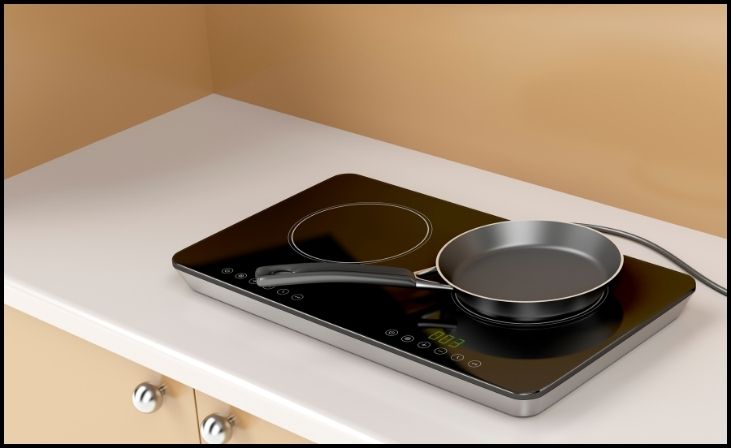
Ceramic glass is used to make induction. A magnetic induction coil provides heat to the cookware, which is then transferred to the food.
Magnetized metal, such as cast iron or steel, is required for pans suited for this type of cooktop. Pans made of copper and aluminum will not heat unless they have a bonded base.
For induction pans to work properly
- Use flat-bottomed pans.
- Do not continuously lift the pan off the stovetop.
- Because the aluminum sides do not heat immediately from the cooktop, so give coated and aluminum pans with steel bases more time to heat.
Hotplate Solid
Solid hotplates are typically built of cast iron with a sealed electric source. Choose a pan with a flat base to achieve even heating without wasting energy.
Ceramic

A ceramic glass electric cooktop requires a heating element below. Always lift pans off the surface rather than slide them to avoid damage. Check the article on the best pan for glass top stoves.
Halogen
Heat is generated by halogen lamps placed below a glass cooktop, transmitting heat and light upwards. Use thick-bottomed pans that can handle high heat. Avoid using bases that are too glossy.
Solid Fuel
For a Solid fuel cooktop, choose pans and trays with sturdy, heat-resistant bases.
Some cookware has temperature restrictions or is not suitable for use in the oven. When the heat source fluctuates, materials like cast iron do a better job of maintaining a stable temperature for even cooking.
The Parts of a Pan
Handle
A solid and comfortable handle makes it easy to pick up and move the pan from the stovetop to the oven. Metal, wood-clad, silicone-coated, and heat-resistant plastic are some of the materials and styles available for handles.
Rivets
Rivets are used to bind the handle to the body of the cookware. Rivets make a strong joint that doesn’t need to be tightened. Screws or welded joints are examples of other fasteners that can be employed.
Body
The pan’s body can be composed of various materials, including stainless steel, aluminum, enameled cast iron, non-enameled cast iron, or copper.
Rim
The pan’s rim or edge can be slightly rolled or straight. Pouring liquids from the pan is easier with rolled rims. Likewise, tossing or stirring items is more manageable with straight edges.
Cooking Surface
The pan’s internal surface is made out of nonstick, stainless steel, and cast iron. Each has its own pros and cons. Clean-up is simple with nonstick. Stainless steel is extremely durable that can be used for browning and sautéing. Cast iron is used on the stovetop and in the oven.
Core
Stainless steel cookware has several metal layers. First, the layer of conductive metals such as aluminum or copper makes up the core.
Base
Smooth-top electric stoves require a flat base. Induction ranges respond better to magnetic materials, such as stainless steel.
Sides
Most saucepans have high vertical sides, which are great for simmering liquids. In addition, many sauté and fry pans have flared sides that help the evaporation of cooking liquids.
When buying cookware, what should you look for?
When buying cookware, there are a few factors to keep in mind. These are some of them:
Heat conductivity
Some metals transfer heat better than others. For example, copper conducts heat well, but stainless steel does not. It means better the heat conductivity, better and more evenly your food will cook.
Price
The amount you spend on pots and pans is a personal decision. However, we don’t prefer sets because many manufacturers combine non-essential products with the more popular ones. Thus, even if the set is not expensive, your savings are insignificant overall when you add up the individual item prices. Also, all the pieces in the set are of the same material.
Durability
Some types of cookware survive longer than others. Stainless steel and hard anodized aluminum are the most lasting materials, but nonstick pans rarely last more than 5 years. On the other hand, Nonstick cookware sets are usually less expensive, so you can quickly replace them.
Reactivity
Specific metals have an adverse reaction when consumed with certain meals. Aluminum, for example, reacts with acidic foods.
Maintenance
You can only find what’s perfect for your kitchen by comparing the upsides and downsides of the various materials available.
Every type of cookware has its own pros and cons. For example, nonstick pans are lightweight, whereas carbon steel pans need careful seasoning to prevent corrosion.
Also, Stainless steel is extremely durable and does not require seasoning. Copper and cast iron cookware require more effort to maintain their shine, although stainless steel cookware is typically easier to maintain.
Portions And Sizing
Sizing is difficult because each kitchen is different. The most important thing is to know who you’re cooking for most of the time.
It’s not true that bigger is better when it comes to cookware. A 20-piece cookware set is unnecessary in most households. That’s a waste of pots and pans and money that you’ll almost certainly never use, and it takes up storage space.
However, you’ll also notice that a 20-piece package can sometimes include many low-quality products that you don’t need. So, The ideal amount of pieces per set for your kitchen is roughly 10-pc.
Types Of Pans
If you’re looking to restock your kitchen with various cookware, you should pay careful attention to the many types of pots and pans.
A cookware set is a good place to start if you’re new to cooking. In addition, purchasing a set can be cost-effective for those who require various pieces. Knowing what they’re good at before buying can save your time and money and improve your cooking delight.
Frying Pan
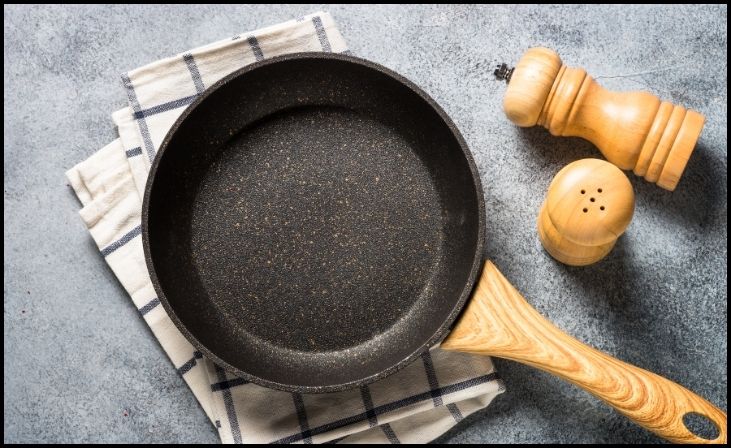
You’ll utilize a frying pan on a daily basis. It’s great for preparing omelets, scrambled eggs, pancakes, sautéing vegetables, and frying meat. This multi-meal must-have has slanted sides that let you quickly move items around when creating omelets or sautéing vegetables.
Skillet

The skillet looks like a frying pan but is made of cast iron. As a result, it has a naturally stick-resistant surface and can easily transfer from the cooktop to the oven. Using a skillet, you can sear, bake, sauté, pan-fry, braise, broil, roast, and more.
Saute Pan
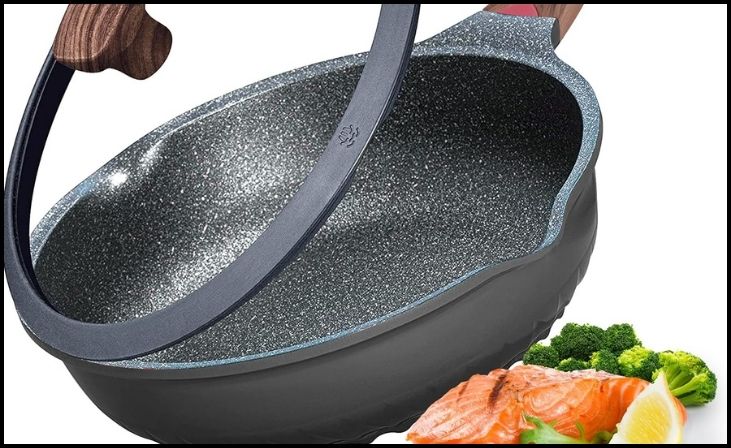
A sauté pan has a wide, flat bottom with vertical, slightly high sides and a long stick handle, similar to a frying pan. It’s used to quickly cook things that require shaking, tossing, or stirring, such as vegetables and meats.
Saucepan

A saucepan is one of the most basic kitchen tools. Soups, rice, potatoes, veggies, gravy, syrups, and more are all made with it. In addition, it can be used to boil, steam, and reheat food.
Stock Pot
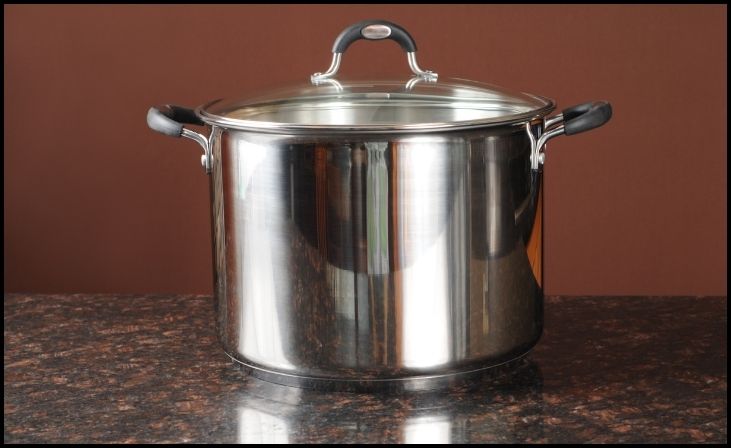
A stockpot is ideal for cooking soups and stews, boiling huge amounts of vegetables, lobsters, crabs, shellfish, and even deep-frying. You can also steam food above water in a stockpot.
Steamer/Pasta Cooker
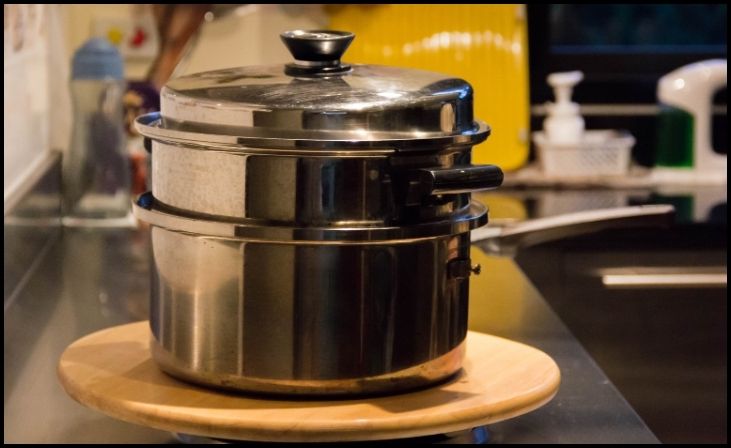
A steamer or pasta cooker is great for making soups, stews, and boiling lobsters. A separate top basket steams vegetables, fish, and other items in the deep-sided pot, which has a pasta insert that lifts out to drain.
Bamboo Steamer
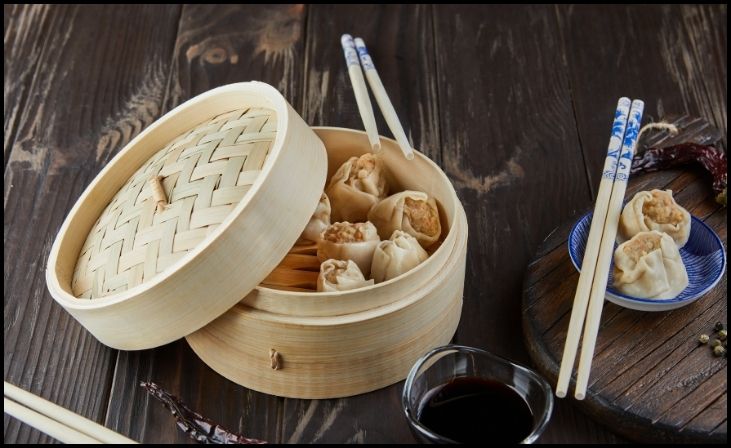
The bamboo steamer ensures that the food is cooked evenly without drying out. It’s the easiest way to prepare many different kinds of dumplings without using any oil or fat. There are many bamboo steamer baskets available.
Griddle
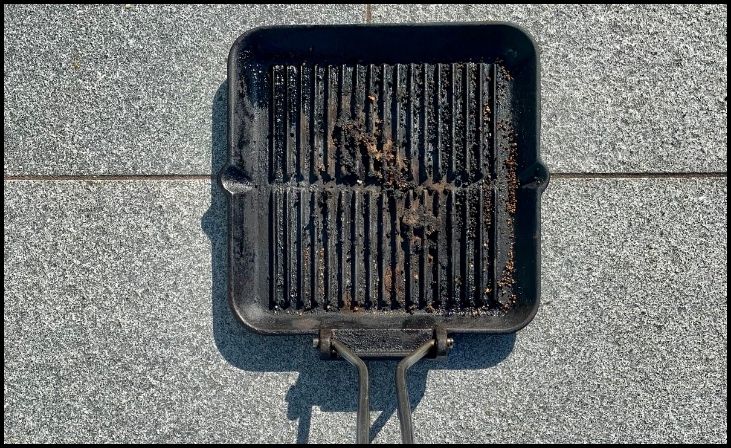
A griddle is a vast, flat pan with a nonstick surface that is ideal for cooking eggs, pancakes, grilled cheese, bacon, hamburgers, and other quick-cooking dishes.
Grill Pan

Grill pans are made for high-temperature cooking methods, including grilling and searing. Choose a cast iron or enameled cast iron grill pan if you want your food to have grill marks. Also, choose one with a nonstick finish for easier cleanup.
Wok

Woks are popular because of their high, sloping sides. The slanted sides make it simple to slide items around the pan. Stir-frying, steaming, and deep-frying are all great uses for them.
Dutch Oven
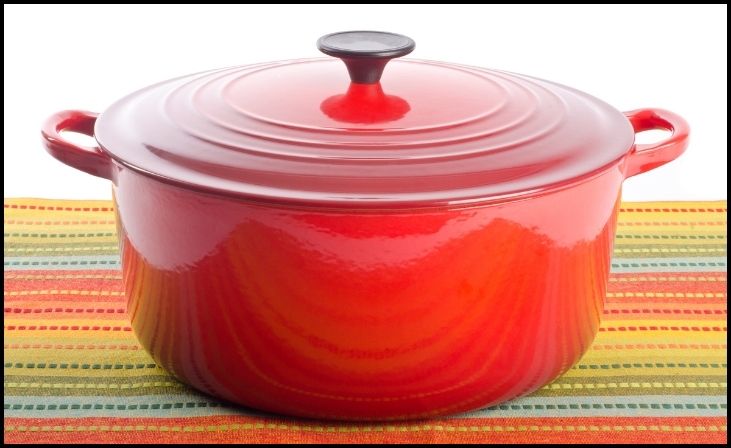
A Dutch oven is a huge, heavy-duty pot. This pot allows you to start a dish on the burner, finish it in the oven, and serve it at the table. Stocks and sauces, roasted chicken, pot roast, stews, risotto, and more can all be made with it.
Le Creuset and Staub Make Best Dutch Oven.
Saucier
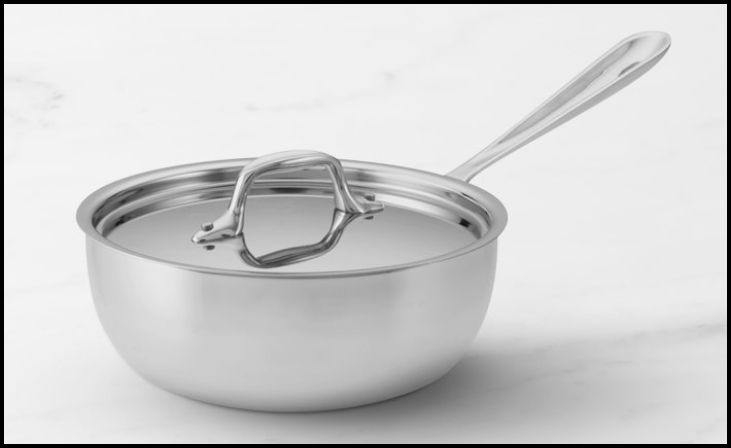
A saucier is identical to a saucepan, except instead of straight edges, it has circular ones. It’s ideal for risotto, oatmeal, and a variety of sauces.
Crepe Pan
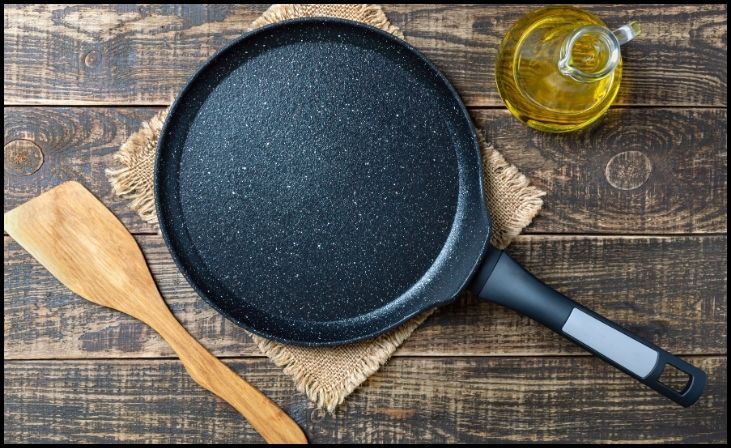
A crepe pan is a shallow, broad skillet with a long handle. This pan allows you to make flawless, thin crepes every time. Nonstick pans are ideal for creating crepes perfectly. These pans are also excellent for omelets.
Pressure Cooker
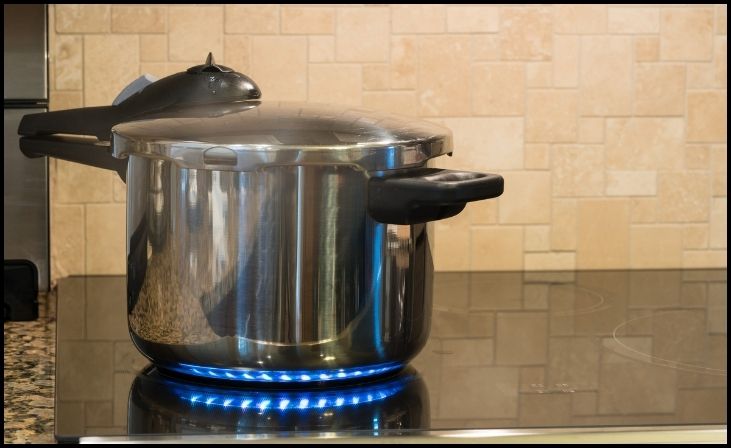
In a Pressure cooker, steam is generated inside a tightly sealed pot, and the pressure rises, causing the items to cook more quickly. You cook beans, grains, and other dishes that take a long time to prepare.
Roasting Pan
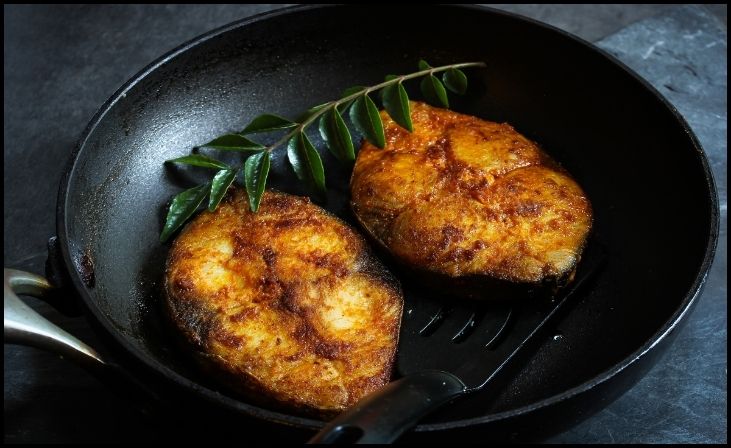
A roasting pan or roaster is a large rectangular pan with low edges that allows the oven’s heat to reach the food. It’s made for roasting meats and poultry at high temperatures. With a roasting rack, roasting pans are usually used.
Paella Pan

The paella pan is ideal for various functions, including sautéing, cooking meat, and fish. Paella pans have a sloping side and are circular, wide, and shallow. Paella pans are typically made of carbon steel, stainless steel, or enameled steel, all of which are easy to clean.
Casseroles

Casseroles come in various sizes and shapes, including square and circular. Casseroles are made of specific materials, including ceramics, glass, and enameled cast iron. Casseroles also have a pleasing appearance, making them ideal for serving meals.
Best Cookware Materials
We have a list of the top cookware materials, each with its own set of advantages, whether you require lightweight aluminum, traditional cast iron, durable carbon steel, or classic stainless steel pots and pans.
Stainless Steel
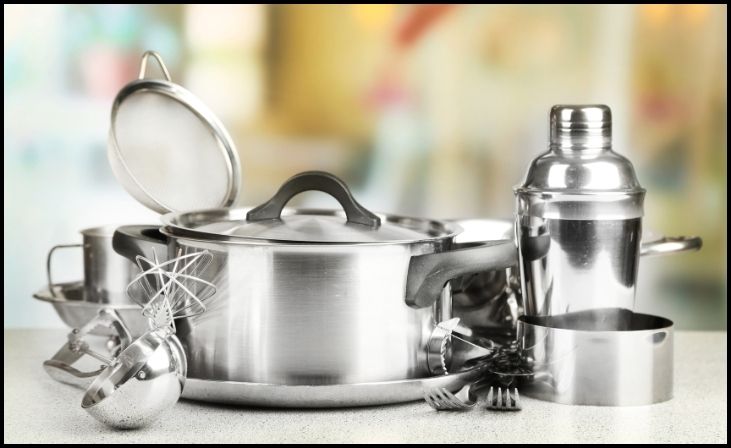
Stainless steel cookware is non-reactive. A strong metal core extends from the bottom of the pan all the way up the sides of the pan, ensuring uniform heat distribution during cooking.
Dishwasher-safe and long-lasting, it’s suitable for both induction and standard cooktops. The most significant disadvantage of stainless steel is that it is less user-friendly than other materials such as nonstick.
Nonstick
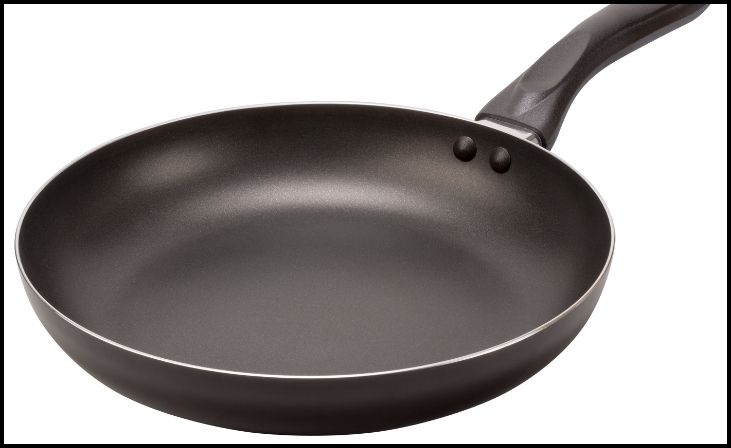
Nonstick cookware is an excellent choice for low-fat foods because they require little to no oil. Even delicate meals, such as eggs and pancakes, are simply released by nonstick coatings.
Allow pans to cool completely before cleaning them, and avoid putting hot pans in cold water. Most nonstick cookware is dishwasher-safe, but regular use might damage the nonstick surface.
Ceramic
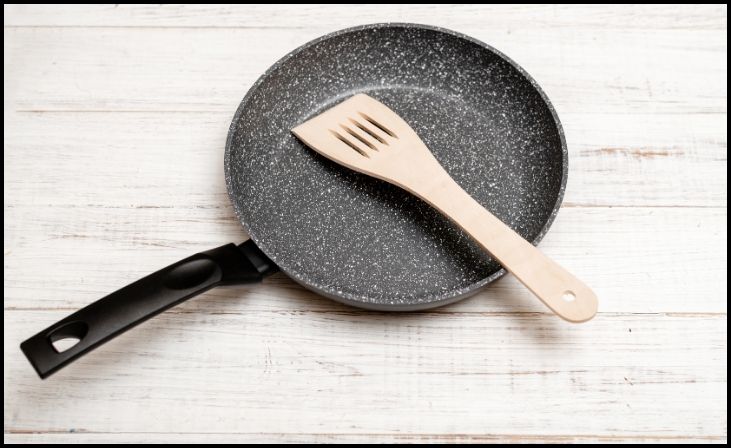
Ceramic nonstick cookware is scratch-resistant and free of PTFE and PFOA. The aluminum core of this fully clad 3-ply cookware ensures quick and equal heat conduction, while the magnetic stainless steel outside is compatible with all sorts of cooktops, including induction.
Ceramic pans are often the cheapest option, but they have less durability. However, it’s safe to use on any type of burner, including induction.
Cast Iron

Most cooks have trusted cast iron for its affordability, durability, and ability to survive the high temperatures required for searing and frying, slow-simmering stews, and slow-roasting foods. It’s an excellent substitute for nonstick cooking surfaces.
On all stovetops, even induction, You can utilize cast iron. Allow cooling before cleaning with plain water or mild soapy water. Re-season at least once a year.
Carbon Steel
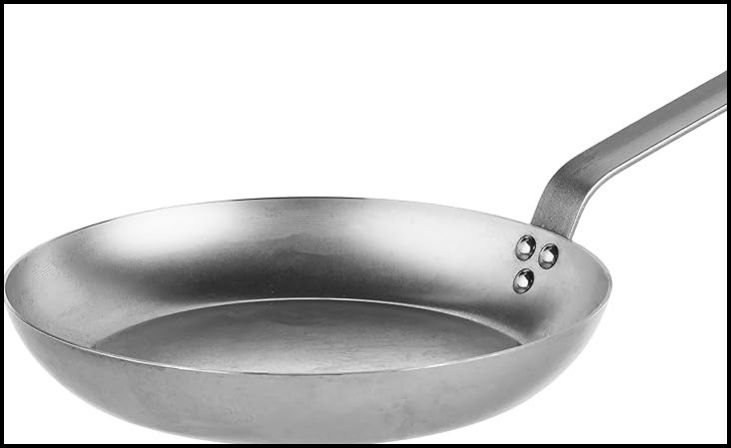
Carbon steel is similar to cast iron. However, it is incredibly durable and efficient and intended for high-performance cooking. These pans are favorites in professional kitchens. Check Out Misen carbon Steel Pan Review.
It’s more expensive than cast iron, and the thinner composition means it doesn’t retain heat as well.
Enameled Cast Iron
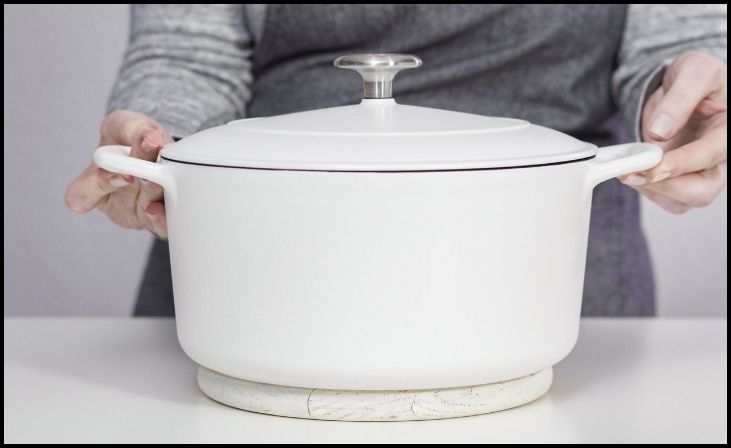
Enameled cast iron is best used at low to medium temperatures. It is nonreactive and does not absorb aromas or flavors, making it perfect for cooking acidic dishes like tomato and wine sauces.
Smooth, carbonized porcelain has been coated over enameled cast iron to help prevent rust, make cleaning easier, and eliminate the need for seasoning.
Copper
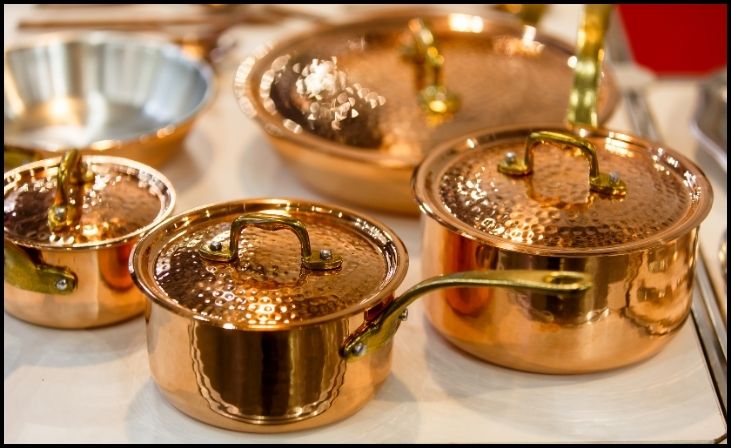
Copper is the ideal element for cooking delicate foods because of its superior heat conductivity and quick responsiveness to temperature fluctuations. In addition, copper is extremely energy efficient, requiring
It is also the most expensive cookware material, and the tin lining, which prevents a metal reaction with your food, must be maintained with care.
Anodized Aluminum
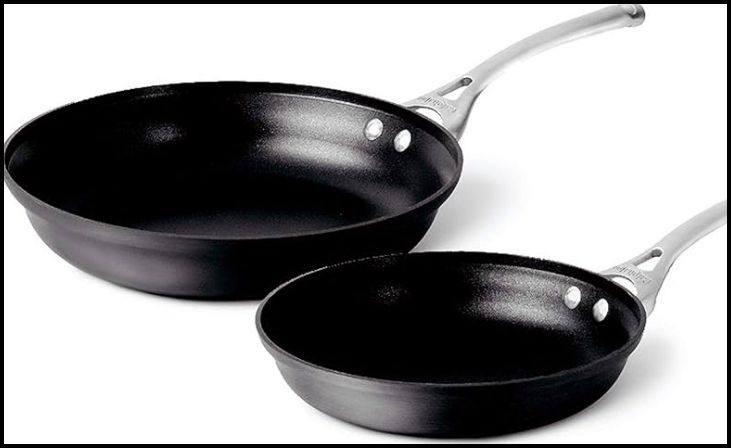
Anodized aluminum is a type of aluminum that is formed into layers and then chemically treated to provide an extremely hard, smooth, and non-reactive surface. This material is ideal for skillets, saute pans, stockpots, and roasting pans.
It is the most cost-effective cookware. Unfortunately, most anodized cookware has a nonstick coating, which reduces its longevity.
Glass
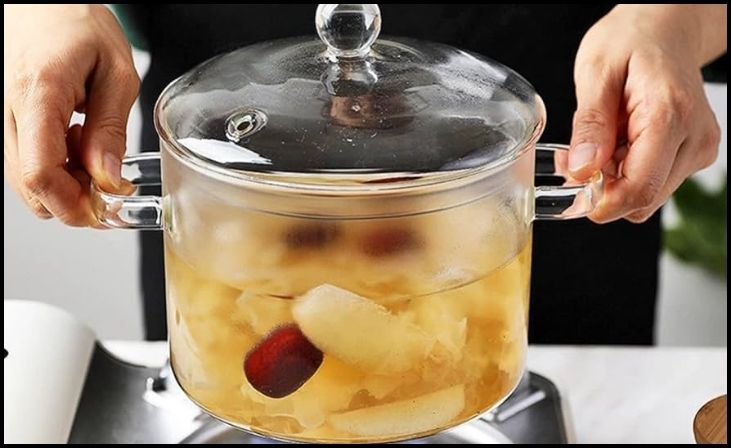
Glass cookware is usually constructed using tempered glass, which is tougher and more difficult to break. Glass is nonreactive and excellent at retaining heat. This makes it ideal for roasting meat and vegetables and preparing savory recipes in the oven.
It is extremely strong and scratch-resistant. It’s also dishwasher safe.
Best Cookware Brands
All-Clad
All-Clad is one of the most costly brands. Stainless steel and copper-core items are the mainstays of All-product Clad’s line. Many pro kitchens use All Clad’s D3 and D5 lines, and many aesthetically oriented home kitchens use their luxury Copper Core series.
Calphalon
Anodized aluminum, nonstick and uncoated stainless steel, and other materials are available in this moderate to high-end brand. Similar to All-Clad, they now offer three-layer and five-layer designs.
Le Creuset
Le Creuset produces some of the world’s toughest enameled cast iron. The Signature Cast Iron Skillet is pricey but generational kitchen equipment.
Lodge
The lodge is a popular American brand known for its low-cost cast iron cookware, and many experts say that its skillets are just as good as those from higher-end brands. Their lightweight Chef Collection skillet is one of the most versatile on the market.
T-Fal
T-Fal makes high-quality, low-cost cookware that may be bought on a low budget. While T-Fal cookware may not be as well-known as All-Clad in terms of brand recognition, the build quality is more than adequate for many years of use. While T-Fal’s nonstick pans are widely available, the company has recently expanded into ceramic cookware.
GreenPan
GreenPan was the first company to introduce a PTFE-free option to the market. This Belgian cookware company, together with GreenLife, created a new category for the healthiest cookware. While it isn’t our favorite ceramic frying pan, the branding is great, the pricing is reasonable.
Scanpan
Scanpan heavy-gauge pot or pan sits exactly level, evenly distributes, and holds heat for hotspot-free cooking, and is finished with a ceramic-titanium nonstick coating that can handle metal spatulas. The handles and the stainless-steel lids have a dual matte/polished appearance that looks great against the black pan.
Swiss Diamond is a good option if you’re looking for nonstick cookware that balances convenience and environmental concerns.
Anolon
Anolon is a well-known company that offers high-quality items at reasonable costs. Anolon nonstick pans are a great option if you don’t want to spend a lot of money on them. It is made of high-quality, triple-layer nonstick material and has a long lifespan. It is designed for durability, convenience, and long-term use.
Circulon
Cookware Brands’ Circulon cookware collection includes high-quality items that offer the greatest in cooking performance. You can make great foods with options compatible with induction stovetops, traditional stovetops, and ovens, regardless of your favorite cooking method. The sturdy construction of the Circulon enables even heat distribution and stress-free cooking.
Cuisinart
Cuisinart is a mid-to high-priced brand that offers nonstick and uncoated products in stainless steel, hard-anodized, and multi-clad materials. Instead of using petroleum-based surfaces, Cuisinart’s Green Gourmet Cookware employs ceramic.
Other Brands
There are a lot of other cookware companies to list.
Companies like Tramontina and Cuisinart have introduced knock-off pots and pans based on the success of their other cookware.
Red Copper, Copper Chef, and Gotham Steel, to mention a few, are among the many items.
Stick with the tried-and-true brands that are trusted by the toughest kitchens is our advice.
How To Care For Your Cookware
Kitchen necessities often require some care and love. Even the greatest cookware, Dutch ovens, and cast-iron pans require care and attention. To extend the life of your cookware, follow these guidelines, which include appropriate cleaning and induction use.
As soon as you notice a burnt-on stain, treat it immediately
Soap, water, and the scrubbing side of a sponge should be your first layer of protection on cookware, including cast iron. If that doesn’t work to remove burnt places, you’ll need to try something else.
Stainless steel, copper, and enamelware: Fill the pan half with a solution of vinegar and water and bring to a boil. It should remove most stains; Also, you may let the pan cool before washing it with soap and water.
Do you have any more dark spots? Then, it would be good to get a Bar Keepers Friend container. When you want your pots and pans to shine like new, this non-bleach chemical cleaning might be a lifesaver. Make a paste of water and the powder, apply it to your pan’s bottom and scrub hard until the stains are gone. Try Bon Ami if you prefer an all-natural product.
Cast-iron and nonstick: Nonstick pans are more difficult to burn. You must be cautious when dealing with any stuck-on food. To gently wipe the inside and remove any waste, use baking soda and a sponge—rather than a chemical abrasive. After any serious scrubbing, make sure to re-season your pan.
Season your cast-iron skillet as well as your nonstick pan
You need to re-season your cast-iron pans to keep them from rusting and retaining their nonstick features. For seasoning, put some oil on a paper towel and try rubbing the inside of the pan.
You can eliminate this step if your nonstick cookware is ceramic. For cast iron, do not heat the pan after oiling it. Because cast iron cannot sustain extremely high heat.
Are you unsure how to care for your cast iron? Cast Iron guide will tell you all you need to know. Simply wash and dry properly, and season on a regular basis. If you’re looking for a new pan, have a look at our list of the greatest cast-iron pans.
Use the appropriate utensils
Metal tongs, spoons, and spatulas can be used on cast-iron and stainless steel, but they should not be used on nonstick surfaces. For nonstick cookware, we recommend wooden spoons or soft silicone spatulas.
Carefully wash, dry, and store
The dishwasher is safe for stainless steel cookware but not for cast iron or nonstick. Our suggestion is handwashing which is better for longevity.
Handwashing enamelware is also recommended because it is prone to cracking. Stack your cookware in such a way that cast-iron and stainless steel do not scratch your nonstick pans.
Don’t use the same procedure for each pan
Every type of cookware is unique, with its own set of characteristics and restrictions. To properly care for each, be sure you understand what you’re dealing with! Check out our tips on stainless steel, nonstick, and cast-iron care if you still have questions.
Making The Final Decision
Choosing between stainless steel, cast iron, copper, or aluminum is a personal choice dependent on your culinary expertise and your budget.
Stainless steel cookware would come out on top for overall versatility, usability, and affordability. However, it does have one significant disadvantage: it does not conduct heat efficiently, which is critical if you want properly cooked dishes.
Clad cookware is the answer to this problem. Multiple layers of different metals are used to make this type of cookware. So search for stainless steel cookware with a layer of copper or aluminum sandwiched in the base. Although stainless steel cookware with a copper base is more expensive than cookware with an aluminum base, it has the advantage of superior heat conduction. In further depth, You can check our Most expensive cookware article.
When it comes to cookware, take your time, get the best you can afford, and follow the manufacturer’s directions for caring for your pots and pans.


Leave a Reply